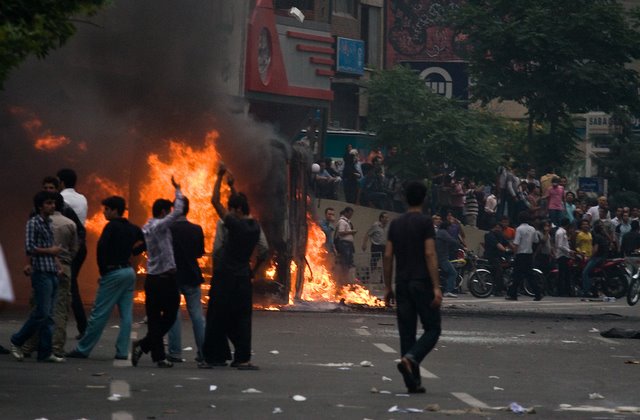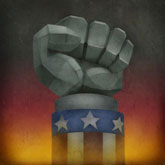Photos: Iranian Dissidents Document Election Brutality
As Iranian President Mahmoud Ahmadinejad prepares to speak to the United Nations General Assembly on Wednesday, TWI is publishing a trove of photographs documenting the summer’s uprising against the disputed election has emerged, thanks to a dedicated network of digital smuggling.
Jul 31, 2020243.4K Shares3.3M Views
*WARNING: Photos in the slideshow below depict graphic violence. *
As Iranian President Mahmoud Ahmadinejad prepares to speak to the United Nations General Assembly on Wednesday, a trove of photographs — most of which have never before been published — documenting the summer’s uprising against the disputed election has emerged, thanks to a dedicated network of digital smuggling.
Most of the photographs were taken by Iranian dissidents themselves, and several were shot with cell-phone cameras while in the midst of the protests that shook Tehran following the disputed June 12 elections. Some are extremely graphic, and show a level of repression exhibited against the Iranian people that did not appear in Western media. There are images of the aftermath of rubber-bullet welts, security forces on motorcycles terrorizing women, and bloodied protesters.
Illustration by: Matt Mahurin
The protests caught the world’s attention and led to a sustained crackdown on the Iranian opposition, particularly its ability to communicate with the outside world. One image shows the wreckage of a computer lab at Tehran University after regime elements targeted it in June. Human rights groups have documented widespread detentions and prison abuses, including rapes. On Sept. 11, Ayatollah Ali Khamanei, the supreme leader of Iran, threateneda “harsh response” to those who continue denouncing the government. Yet this weekend, thousands of demonstrators turned the annual Jerusalem Day celebration into an occasion to denounce the regime at great personal risk.
As a result of the crackdown, tech-savvy dissidents have created a network stretching far outside of Iran to pass information out of the country. Sympathetic political activists outside of Iran operate clandestine servers beyond the regime’s technological reach that serve as a clearinghouse for information like these photos. TWI was given access to one such server on condition of anonymity, by Iranian dissidents and their international allies in advance of Ahmadinejad’s remarks to the U.N. general assembly — anticipated to focus on a defense of the Iranian nuclear program — at a time when many in the Iranian opposition worry that global interest in Iranian repression has dissipated.
“Do not accept our government as the one we (the Iranian people) have chose[n], or even that they are legal,” said an anonymous Iranian dissident in a message, delivered through an email from a non-Iranian ally, explaining why the dissident was allowing a reporter to view a sampling of the photographs. “Do not believe anything our president says. Do not believe their claim for nuclear power to be peaceful. They have no credibility, you can not trust them, this election was proof of that. They stole our votes, and silenced our protest against them. “ *WARNING: Photos in the slideshow below depict graphic violence. *
Image has not been found. URL: http://btemplates.googlepages.com/add.gif
At a speech Friday previewingthe U.S. agenda for this week’s general assembly session, Secretary of State Hillary Rodham Clinton said that the Iranian regime had to make a fundamental choice about whether it wanted warmer relations with the U.S. and Europe, a path accessible only through a perishable offer to negotiate on issues beyond Iran’s nuclear program. “The international community has made abundantly clear what is possible for all Iranians if Iran lives up to its responsibilities on the nuclear issue – the benefits of economic connections to the rest of the world, cooperation on peaceful nuclear energy, and partnership in education and science,” she said. “But there will be accompanying costs for Iran’s continued defiance – more isolation and economic pressure, less possibility of progress for the people of Iran.”
Clinton singled out the regime’s treatment of its dissenters, denouncing it for launching “a campaign of politically motivated arrests, show trials, and suppression of free speech” and saying it “stands in the way of the justice it seeks.”
The Iranian uprising and subsequent crackdown “undoubtedly complicated” the Obama administration’s efforts at diplomacy with the regime, and forced the administration to reconsider some of its assumptions, one administration official conceded. “First, there was the concern of not wanting to do anything that may undermine the Iranian opposition,” said the official, who spoke on condition of anonymity. “They also splashed cold water on any possibility of making real substantive gestures towards Iran beyond symbolic outreach, raised the domestic political costs of engagement, and most importantly ensured that in the short-term Iran would be ruled by a more hardline regime less likely to negotiate. The elections also caused a significant delay in our engagement policy by ensuring that rather than looking outward Iran would be internally absorbed and unable to make major foreign policy decisions.”
Yet as the Iranian regime has looked inward — which, in this context, means violently suppressing dissent — some Iranian human-rights advocates believe the world has looked elsewhere. On Monday afternoon, Human Rights Watch and the International Campaign for Human Rights in Iran will hold a joint press conference across from U.N. headquarters in New York, in which a tortured Iranian dissident will speak.
“The Iranian government is doing its best to prevent any news from inside Iran to reach the outside word,” said Hadi Ghaemi, the director of the International Campaign for Human Rights in Iran. “The level of repression is increasing and detentions of activists is continuing. But the international community should realize that the protests in Iran are not over, just as we saw yesterday with tens of thousands risking their lives to publicly protest. As Ahmadinajed comes to the U.N., the focus should be on the grave human rights violations of the past three months: murder of protestors, torture and rape of detainees. The U.N. General Assembly should hold Ahmadinejad accountable by appointing a special envoy to investigate and document the extent of crimes that have taken place.”

Rhyley Carney
Reviewer
Latest Articles
Popular Articles

